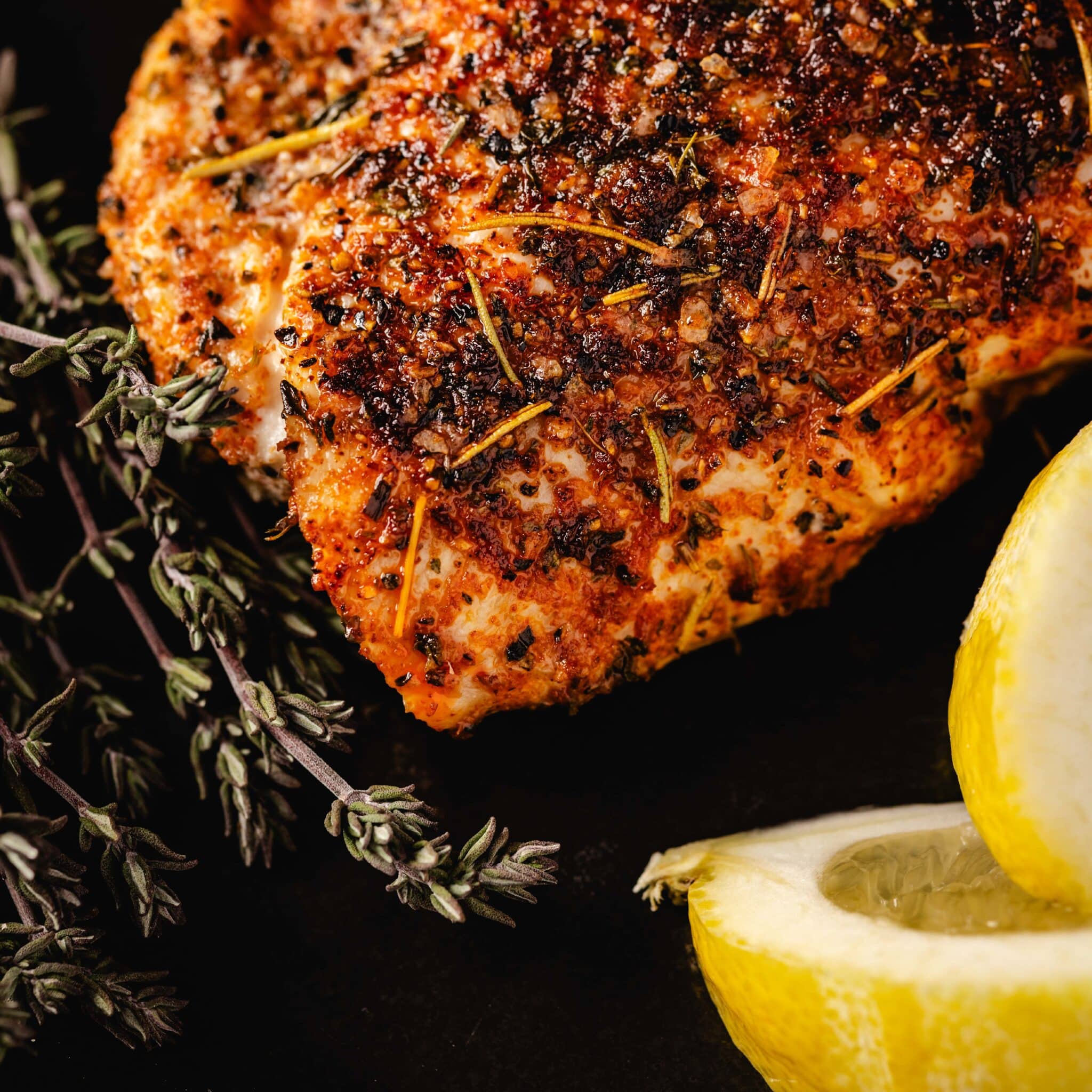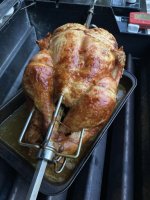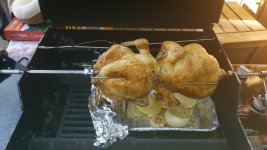You are using an out of date browser. It may not display this or other websites correctly.
You should upgrade or use an alternative browser.
You should upgrade or use an alternative browser.
Rotisserie Crispy Skin
- Thread starter THyde
- Start date
THyde
TVWBB Guru
Knife was already cleaned and put away. Our gigantic poodle likes rotisserie chicken so I always clean all the knives before leaving the sink unattended. In that interval of time thighs and drumsticks were STOLEN from my carved chicken presentation!!!
Chuck, any tips on the rub you use for that bird?
I'm still excited about this, and totally planning my next bird!
Chuck, any tips on the rub you use for that bird?
I'm still excited about this, and totally planning my next bird!
ChuckO
TVWBB 1-Star Olympian
Good eye! That rub is bomb!!! It comes from Susie @ Hey Grill HeyKnife was already cleaned and put away. Our gigantic poodle likes rotisserie chicken so I always clean all the knives before leaving the sink unattended. In that interval of time thighs and drumsticks were STOLEN from my carved chicken presentation!!!
Chuck, any tips on the rub you use for that bird?
I'm still excited about this, and totally planning my next bird!
Ingredients
- 1 Tablespoon kosher salt
- 1 Tablespoon smoked paprika
- 2 teaspoons black pepper
- 1 teaspoon dried rosemary
- 1 teaspoon dried parsley
- 1 teaspoon dried thyme
- 1 teaspoon garlic powder
- 1 teaspoon onion powder
- 1/2 teaspoon cayenne pepper
- 1 zest of 1 lemon
Instructions
- Combine all ingredients. Use a fork to mix all ingredients in a medium-sized bowl.
- Season and store. Sprinkle seasoning liberally on chicken before grilling, roasting, or searing. Seasoning mix can be stored in an airtight container for up to 6 months.

Lemon Herb Chicken Seasoning [with Video] - Hey Grill Hey
The lemon herb chicken seasoning is so simple to make at home and uses common pantry ingredients so you can make a batch to have on hand.
ChuckO
TVWBB 1-Star Olympian
Make you you have or get the micro planer because the ZEST is mandatory. Get one hereWow, thanks! Looks like I have a shopping list!
I'm going to try to combine everybody's tips into the ultimate Crispy Skin Rotisserie Chicken next week!
Starting with an overnight dry brine, a cooking temp closer to 400 and I will have to produce some pictures again.
THyde
TVWBB Guru
The lemons are probably the only thing that I really need to have on the list. I will get the micro planer now. Thank you!
I should think about this. If I end up able to make chickens that good, it might turn into "careful what you wish for". I'll be spinning chickens constantly!
Actually, what's so bad about that?
I should think about this. If I end up able to make chickens that good, it might turn into "careful what you wish for". I'll be spinning chickens constantly!
Actually, what's so bad about that?
Rick P
TVWBB Pro
That looks fantastic!I do a lot of rotisserie chicken, and high-heat is critical. I use a two zone, three is too much (imho)
Unfortunately, I find that when I remove the chicken from the BBQ, the skin is crispy as wanted, however during carving, the skin gets wet in the carving process from all the moisture in the chicken, and by the time it's all said and done, it's no longer crispy. YMMV
Quick question,(on the assumption that those are Weber grill baskets) : Why do you set the charcoal baskets to one side, as opposed to both sides?
ChuckO
TVWBB 1-Star Olympian
This is my opinion, and there's no science that I know of to support it. The main reason to rotisserie anything is the self-basting that naturally occurs. In my opinion having heat on both sides of the cook, reduces the self-basting. I used to do a 3-zone cook (heat on both sides) until one day I got lazy and only did one side. The result was hands down better than my 3-zone cooks, and I've never 3-zoned cooked again. I rotisserie chicken a lot, turkey a couple times a year and prime-rib roast at Christmas. I find that my 2-zone cooks far exceed my previous 3-zone cooksThat looks fantastic!
Quick question,(on the assumption that those are Weber grill baskets) : Why do you set the charcoal baskets to one side, as opposed to both sides?
Rick P
TVWBB Pro
Makes sense to me!This is my opinion, and there's no science that I know of to support it. The main reason to rotisserie anything is the self-basting that naturally occurs. In my opinion having heat on both sides of the cook, reduces the self-basting. I used to do a 3-zone cook (heat on both sides) until one day I got lazy and only did one side. The result was hands down better than my 3-zone cooks, and I've never 3-zoned cooked again. I rotisserie chicken a lot, turkey a couple times a year and prime-rib roast at Christmas. I find that my 2-zone cooks far exceed my previous 3-zone cooks
I'm going to spin a 20lb bird for Thanksgiving and I'll give it a try.
I have a Slow n Sear in one of my kettles. I might use it, instead of instead of the charcoal baskets, depending on how much of the bird sticks over the lit coals.
Thanks!
Michael Richards
TVWBB Emerald Member
Ok, that makes enough sense for me to try it!This is my opinion, and there's no science that I know of to support it. The main reason to rotisserie anything is the self-basting that naturally occurs. In my opinion having heat on both sides of the cook, reduces the self-basting. I used to do a 3-zone cook (heat on both sides) until one day I got lazy and only did one side. The result was hands down better than my 3-zone cooks, and I've never 3-zoned cooked again. I rotisserie chicken a lot, turkey a couple times a year and prime-rib roast at Christmas. I find that my 2-zone cooks far exceed my previous 3-zone cooks
ChuckO
TVWBB 1-Star Olympian
It's hard to say, I really don't know. I'd try using one burner on full speed and see how you like it and if you think there's room for improvement, try two burners. On my kettle, 2-zone works best for me. You do have a drip pan right? You'll have a grease fire bigger than not if you're not using a drip pay. Nothing sadder than a grease fire, the black smoke ruins the cook instantlySo to adapt this to an old Genesis, do you recommend using only one burner maybe set on high? I could probably hit 400 with just one burner, then use the new SearSkin technique at the end!
THyde
TVWBB Guru
I've been spinning them without a drip pan for a while now. There aren't flameups because I only use the front and rear burners, so any flames that might appear are not directly under the spit. You threw me off calling it two zone, but now I am thinking you mean one hot zone and one indirect zone. By that nomenclature, I've been doing three zone rotisserie cooking, one hot zone in front, indirect zone in center, and another hot zone in the back. I'm thinking that using only one burner, all the way on high would probably get me around 400 inside the grill, and would be a lot like your two zone method.It's hard to say, I really don't know. I'd try using one burner on full speed and see how you like it and if you think there's room for improvement, try two burners. On my kettle, 2-zone works best for me. You do have a drip pan right? You'll have a grease fire bigger than not if you're not using a drip pay. Nothing sadder than a grease fire, the black smoke ruins the cook instantly
Also, went to the Restaurant Store and picked up a lemon zester today! Along with a good knife sharpener, but I digress.
LMichaels
TVWBB 2-Star Olympian
I typically do one burner wide open, and add a second if needed to maintain heat as necessary. As long as you're using an old (true IMO) Genesis you're golden. On my Wolf I use the IR burner wide open and add 2 outer burners to maintain heat on the ends and for added smoke. A word of caution. If you use the Genesis make 100% sure you have a catch pan under the bird and maintain liquid in it. It will evaporate quickly when doing a high heat spin
THyde
TVWBB Guru
One burner it is!
I've been doing them with two burners (front and rear on an old Genesis 2000) for a couple years without a catch pan and without water because I want the skin to crisp. For a while I was using a homemade "catch pan" out of tin foil I would be able to throw out after the cook, but since even then I did not have problems with flareups I found I could just skip a catch pan. There was usually just a little stuff on the foil when I was done, no liquid and not really much material would be on the foil at all. So I stopped doing it. I do dry the bird after the brine, this most recent chicken I patted extra dry per recommendations. I also find it important to make sure I drain the water out of the inside of the chicken after wet brining for half an hour. I'll stand it up and let it drip out while I mess around getting my string ready for the truss step and while I go in the basement for the spit. Now I'm thinking a dry brine overnight will trump the potential waterlogging of the skin with wet brining, so I'm going to change to dry brine night before next bird.
I do have a catch pan somewhere. Perhaps a single burner on high and a catch pan is where I can start this next bird next week. With any burner, even one, on high, I can't see the harm putting a catch pan under the chicken.
I'm listening to advice and trying to implement it, the other part is that there are a lot of factors at this point that I am changing suddenly, so I want to make sure that I control the changes I make so I can learn what change impacts what result. So far, I know I can crisp the skin up a bit with the three burners on full blast for the last ten minutes or so. Lid closed. I will be changing from two outer burners on low / medium to one burner on high for the next cook. I can add a drip pan since I'll have higher heat for longer, that makes good sense. The rub recipe sounds like it won't do anything except make the bird substantially more delicious. And increasing my overall rotisserie temperature up to a target of 400 will also be a substantial change. It was hard even last night to let go of my worries about cooking too hot, for some reason I had it in my head that it was a slow and low thing, but it really isn't . The rotisserie turning makes the whole cook kind of like grilling without grates while infinitely flipping the meat, if that makes any sense. I think I should be more concerned with letting the temperature drop UNDER 400, and especially under 350. Once I spin this bird next week, I can give some detail on what I did.
Bruce, it sounded like you were thinking of doing some experimenting yourself soon, I for one am eager to hear what happens!
I've been doing them with two burners (front and rear on an old Genesis 2000) for a couple years without a catch pan and without water because I want the skin to crisp. For a while I was using a homemade "catch pan" out of tin foil I would be able to throw out after the cook, but since even then I did not have problems with flareups I found I could just skip a catch pan. There was usually just a little stuff on the foil when I was done, no liquid and not really much material would be on the foil at all. So I stopped doing it. I do dry the bird after the brine, this most recent chicken I patted extra dry per recommendations. I also find it important to make sure I drain the water out of the inside of the chicken after wet brining for half an hour. I'll stand it up and let it drip out while I mess around getting my string ready for the truss step and while I go in the basement for the spit. Now I'm thinking a dry brine overnight will trump the potential waterlogging of the skin with wet brining, so I'm going to change to dry brine night before next bird.
I do have a catch pan somewhere. Perhaps a single burner on high and a catch pan is where I can start this next bird next week. With any burner, even one, on high, I can't see the harm putting a catch pan under the chicken.
I'm listening to advice and trying to implement it, the other part is that there are a lot of factors at this point that I am changing suddenly, so I want to make sure that I control the changes I make so I can learn what change impacts what result. So far, I know I can crisp the skin up a bit with the three burners on full blast for the last ten minutes or so. Lid closed. I will be changing from two outer burners on low / medium to one burner on high for the next cook. I can add a drip pan since I'll have higher heat for longer, that makes good sense. The rub recipe sounds like it won't do anything except make the bird substantially more delicious. And increasing my overall rotisserie temperature up to a target of 400 will also be a substantial change. It was hard even last night to let go of my worries about cooking too hot, for some reason I had it in my head that it was a slow and low thing, but it really isn't . The rotisserie turning makes the whole cook kind of like grilling without grates while infinitely flipping the meat, if that makes any sense. I think I should be more concerned with letting the temperature drop UNDER 400, and especially under 350. Once I spin this bird next week, I can give some detail on what I did.
Bruce, it sounded like you were thinking of doing some experimenting yourself soon, I for one am eager to hear what happens!
Richard in NS
TVWBB Wizard
I just did this turkey two weeks ago for our Canadian Thanksgiving and only used the front burner on a Silver C. I always use a drip pan with chicken broth in it so I have something to make gravy out of. Have to add water to it every hour as it evaporates.Lots of great information, and Dan, nice skin!


